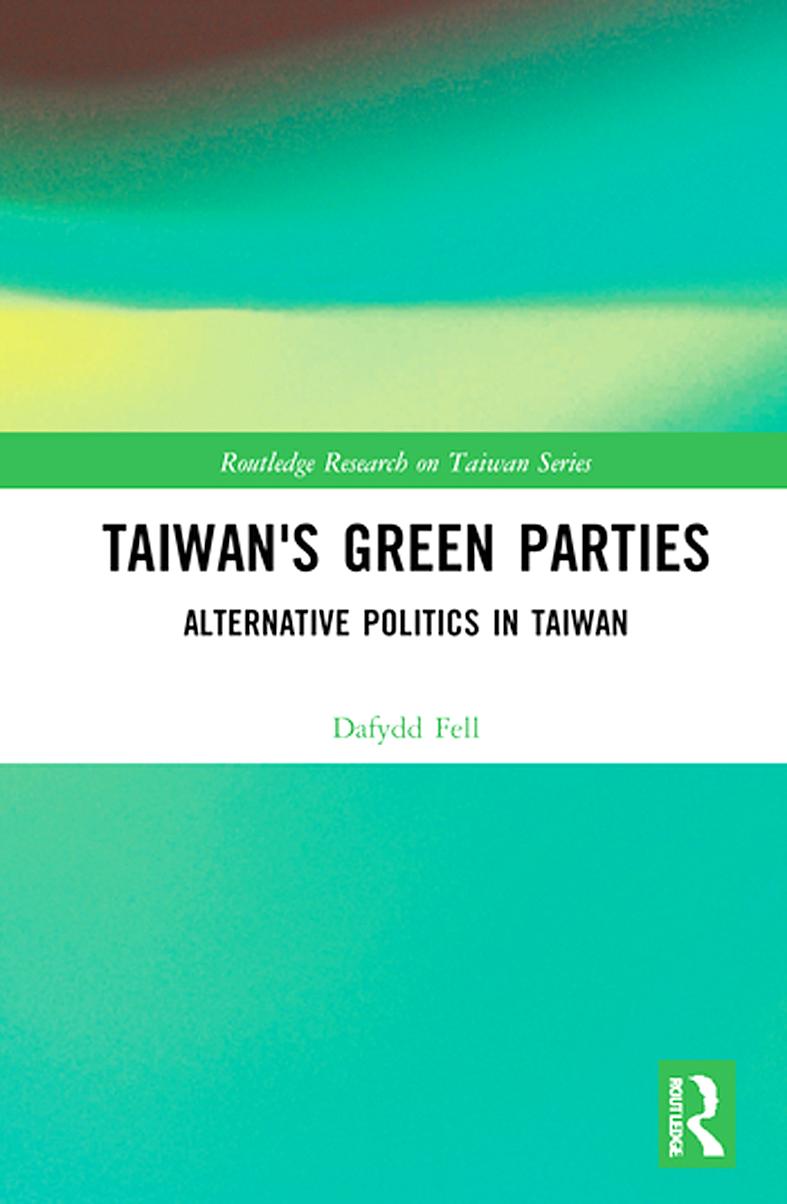The Green Party (綠黨) burst onto the scene in 1996 and claimed one legislative seat just a month after its formation. It never got further than that.
But aside from a dormant period in the early 2000s, the party — which has expanded its interests from purely environmental to social, LGBTQ and even cross-strait issues — has remained somewhat relevant and its members continue to campaign for office with limited success. It must be frustrating for its supporters and scholars like Dafydd Fell, who has closely studied the party since 2012 and has admittedly become emotionally invested, to see it repeatedly squander promising opportunities and suffer from poor decisions and internal strife. But somehow its members just won’t give up.
This is a niche topic in the growing but still niche field of Taiwan studies, and despite Fell’s new book Taiwan’s Green Parties: Alternative Politics in Taiwan being quite an illuminating and intriguing read about activists-turned-politicians and the woes of small party politics (as well as a nice break from the tired drama of the “major” parties), it’ll probably take someone who is extremely interested in Taiwan’s social movements and/or politics to pick it up.

This is not a knock on the book; it’s just that major party politics is already convoluted enough that it takes quite a bit of energy to keep up. At the same time, Fell should be commended for making the corpus of Taiwan political studies more diverse. After all, Taiwan’s Green Parties is the world’s first book-length study on an Asian green party and further highlights Taiwan’s political uniqueness in the region. Note that the title is plural because it includes the short-lived Trees Party (樹黨), which was founded in 2014 by former Green Party members.
Despite Fell’s name appearing all over other academic publications as editor or contributor, this is only the third authored book for the director of the Taiwan Studies Program at the School of Oriental and African Studies, University of London. The other two examine Taiwanese politics from a broader level; Party Politics in Taiwan deals with the evolution of Taiwan’s party politics between 1991 and 2004, and Government and Politics in Taiwan is a general primer on local politics. If you’re not familiar with those topics, read those before you pick up this one.
By contrast, the Green Party book appears to be somewhat of a passion project for Fell, who sprinkles his personal feelings about the events throughout the book and in the acknowledgment section writes that he had become obsessed to the point of talking about the party in his sleep.
That doesn’t mean that this topic doesn’t warrant book treatment in its own right, however. Fell writes that “explaining failure can be as interesting and as valuable as explaining success,” and beyond that, the story of the Green Party is much more than its electoral disappointments.
As a movement party, it has maintained close engagement with the Global Greens community since its inception and has thrown its weight behind various social issues. And most importantly, it’s history is a human interest tale of passionate, idealistic and headstrong people trying to band together to make a difference beyond activism — and how these qualities are also their undoing.
It takes ambition, shrewdness and a willingness to compromise to succeed in politics, whereas at times these Green Party hopefuls are more interested in getting their message out than actually winning. Throughout the book, the party seems to be constantly scrambling to find candidates, members are often more concerned about upholding ideals than electability, and defections to competitors or larger entities are common once disagreements arose. The lack of ability to acquire resources and form meaningful alliances is also glaring.
But that’s what makes them interesting to read about, a completely different breed from your average greasy politician. Their colorful campaign methods — insisting on riding bicycles, making a scene outside a major party’s headquarters, being tied to a tree for 26 hours — makes one wonder about the creative possibilities if it could focus purely on storytelling.
In any event, Fell still does a good job narrating within scholarly constraints, devoting just as much to the people, their personalities and their feelings toward the events as to political analysis. In addition to the information he’s collected over the years, Fell also goes back and asks key Green Party members to reflect on the party’s ups and downs over the past two decades. As expected, they remember different things and offer contrasting explanations.
Academically, the book sets out to examine the overall impact of the party, how the party’s strategies and goals have changed over the years, and explain its decisions and limited electoral fortunes. This is done very thoroughly in a way that’s easy to understand.
Fell divides the party’s history into distinct periods, providing rich and exhaustive data on their activities, strategies, how they fared in elections and why. The interviewees are also separated into four generations, and it’s particularly noteworthy that several older members who stepped away or were ousted for whatever reason have recently returned to nurture and advise the new generation.
Finally, Fell provides suggestions that could be applied to any small, movement-oriented party. Of course, implementing such remedies are easier said than done since personalities get in the way — which makes the human side of the story so important to include in such an analysis.

In the March 9 edition of the Taipei Times a piece by Ninon Godefroy ran with the headine “The quiet, gentle rhythm of Taiwan.” It started with the line “Taiwan is a small, humble place. There is no Eiffel Tower, no pyramids — no singular attraction that draws the world’s attention.” I laughed out loud at that. This was out of no disrespect for the author or the piece, which made some interesting analogies and good points about how both Din Tai Fung’s and Taiwan Semiconductor Manufacturing Co’s (TSMC, 台積電) meticulous attention to detail and quality are not quite up to

It is one of the more remarkable facts of Taiwan history that it was never occupied or claimed by any of the numerous kingdoms of southern China — Han or otherwise — that lay just across the water from it. None of their brilliant ministers ever discovered that Taiwan was a “core interest” of the state whose annexation was “inevitable.” As Paul Kua notes in an excellent monograph laying out how the Portuguese gave Taiwan the name “Formosa,” the first Europeans to express an interest in occupying Taiwan were the Spanish. Tonio Andrade in his seminal work, How Taiwan Became Chinese,

April 21 to April 27 Hsieh Er’s (謝娥) political fortunes were rising fast after she got out of jail and joined the Chinese Nationalist Party (KMT) in December 1945. Not only did she hold key positions in various committees, she was elected the only woman on the Taipei City Council and headed to Nanjing in 1946 as the sole Taiwanese female representative to the National Constituent Assembly. With the support of first lady Soong May-ling (宋美齡), she started the Taipei Women’s Association and Taiwan Provincial Women’s Association, where she

Mongolian influencer Anudari Daarya looks effortlessly glamorous and carefree in her social media posts — but the classically trained pianist’s road to acceptance as a transgender artist has been anything but easy. She is one of a growing number of Mongolian LGBTQ youth challenging stereotypes and fighting for acceptance through media representation in the socially conservative country. LGBTQ Mongolians often hide their identities from their employers and colleagues for fear of discrimination, with a survey by the non-profit LGBT Centre Mongolia showing that only 20 percent of people felt comfortable coming out at work. Daarya, 25, said she has faced discrimination since she